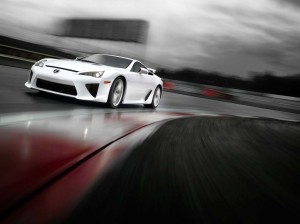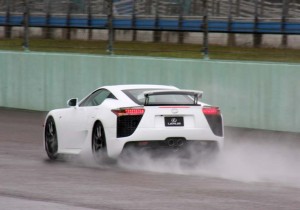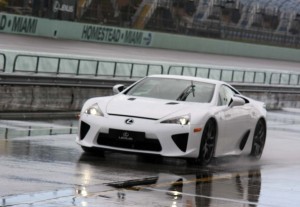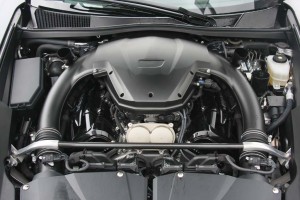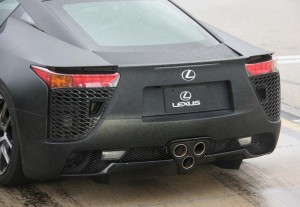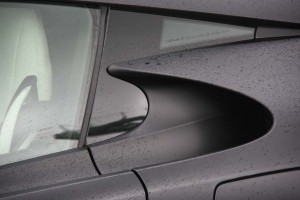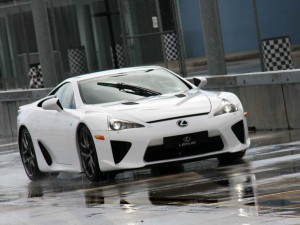So much for sunny Florida. As I pull out of the pits at Homestead Raceway, veteran driver Scott Pruett riding shotgun, the gentle drizzle that had been falling most of the morning has turned into a classic tropical downpour.
Rivers of cool water flow across Turn 1, at the end of the first straight, and my initial inclination is to simply pull into the pits and wait the storm out. But Pruett, putting his life in my hands, only encourages me to go for it. So I squeeze the throttle, shift into fifth and watch the speedo on my Lexus LF-A surge past 100 before it’s time to brake and dive into the flooded corner.
There’s no question having the eight-time Daytona champion along for the ride is a confidence builder, but as I turn laps, gaining speed despite the storm, I realize the real credit goes to the LF-A itself. It’s the sort of car that makes even an average driver feel like he could win Daytona.
Slipping behind the wheel of the LF-A was a long-awaited treat. It’s been nearly five years since the Lexus supercar made its debut, in concept form, at the North American International Auto Show, in Detroit.
In fact, the skunk works program had quietly already been underway for half a decade, but turning out a car like this proved to be a serious challenge for a carmaker best known for its comfortable but bland luxury sedans.
Indeed, about halfway through, “The development team realized they couldn’t reach their targets” with the car they’d come up with using a bonded aluminum chassis, noted the resident Lexus technical wizard, Paul Williamsen. It would have simply been too heavy, so they made a dramatic switch to carbon fiber-reinforced plastic, which now accounts for 65% of the chassis and much of the 2011 Lexus LF-A’s body panels.
A revised version of the supercar made its appearance, again in Detroit, during the January 2008 show, about when Lexus acknowledged it was more than just a design exercise. And so, on the same soggy day I got to drive one of the two final LF-A prototypes in the U.S., the production car was making its formal debut at the 2009 Tokyo Motor Show.
There’ve been a few modest changes to the body shown two years ago, most notably to the fighter jet-like scoops that sits, about mirror height, just behind the two doors. They’re enhanced to draw as much air as possible into the LF-A’s rear, where twin radiators are mounted.
There are, in fact, scoops everywhere, a big grille up front, with smaller inlets on either side used by both the oil coolers and to chill the massive front ceramic brakes. A small slit on the nose – which looks, at first glance, like the hood hasn’t closed – pulls air in for the engine. Another two side scoops, at sill level, behind the doors, cools the rear brakes. And there are yet more scoops in the front wheel wells – to drive even more air to the engine – and on the underside of the body for exhaust system cooling.
Add the automatically-deployed rear wing and everything is carefully integrated into an aerodynamic whole intended to both cheat the wind and maximize downforce at high speeds. It’s useful when you’re pushing the Lexus LF-A to its top speed of 202 mph, or launching it from 0 to 60 in a neck-snapping 3.6 seconds.
While the LF-A’s chassis was a serious engineering challenge, the Lexus engineering team faced an equal hurdle developing the supercar’s 4.8-liter V10 engine, which uses its own unique architecture and which will be produced at the same Toyota Motor Co. foundry currently producing engines for the Japanese automaker’s Formula One cars.
Developed with the assistance of Yamaha, the V10 features titanium valves and connecting rods, the better to reduce mass and increase revs up to a 9,000 RPM redline. The engine uses a dry sump lubrication system which offers several key advantages. For one thing, it allows the engine to be mounted much lower than one using a conventional oil pan. The system holds three times more oil, which Lexus uses as much for engine cooling as for lubrication.
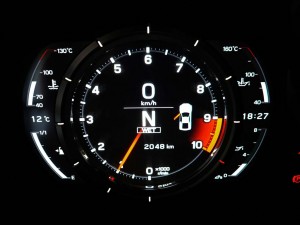
Lexus LF-A uses a reconfigurable digital instrument cluster, and can instantly display vehicle info or a lap timer.
When the engine is screaming close to redline is when it’s making its maximum 552 horsepower. The 354 lb-ft torque peak comes in just below 7,000 RPMs. Those are impressive numbers in any vehicle, but consider all that effort to scrape off excess weight. The 2011 Lexus LF-A tips the scales at just 3,263 pounds. Do the math and you’ll come up with a power-to-weight ratio of 5.8, about as good as it gets unless you’re driving one of the cars Scott Pruett mans for a living.
All that power is channeled through a rigid torque tube to a rear-mounted, 6-speed Sequential Manual Gearbox. In Auto mode, this electronically-shifted manual transmission operates as an automatic, but it has several additional manually-shifted modes, including Sport, which adjusts not only the transmission, but throttle control and various brake-modulated systems like Stability Control. There’s also a Wet mode, which defaults to gentler shifts, something I found very useful on the drenched Homestead tarmac.
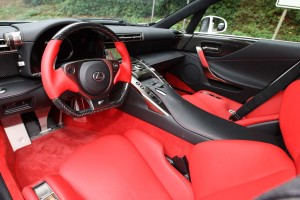
Don't be surprised if the look of the 2011 Lexus LF-A interior influences future products for the brand.
The final link is a set of 20-inch Bridgestone Potenza tires, a design so new the Japanese tire manufacturer won’t let Lexus talk about them yet. A full 10.5-inch wide in the rear, one of the more pleasant surprises was just how well the Potenzas held the pavement in the rear. These very sticky tires are mounted on wide BBS wheels.
One of the more interesting design features of the LF-A is the triple tailpipe, stacked in a triangle. In typical Lexus fashion, engineers spent a lot of time on he exhaust system, not just to maximize flow-through or to ensure cooling, but to get just the right sound out of a V10 that, noted Williamsen, “doesn’t normally lend itself” to a pleasant exhaust note. The original Dodge Viper’s ten-banger emitted a raucous, truck-like note that was perhaps the singular most disagreeable feature to the car. But the 2011 Lexus LF-A manages to produce a surprisingly pleasant road somewhere between a classic V-8 and a Formula One car. And a slick gasket system intentionally passes some of the sound to the passenger compartment.
The interior package is far and away the most elegant and sophisticated Lexus as ever come up with. The futuristic seats are comfortable yet incredibly supportive, and the leather is enveloping. We’re told you’ll see the influence of the cabin design on future Lexus products.
Anything you need to touch is within easy reach. Gauges and read-outs are designed to minimize the time you need to take your eyes off the road. One of the most intriguing features is the reconfigurable instrument cluster, which is actually a large TFT video display. The single, circular read-out is revised for each transmission mode setting, and if you toggle the joystick on the left of the asymmetric steering wheel, the display shifts right, making room for a variety of additional read-outs, including a lap timer.
The 2011 Lexus LF-A also borrows the Remote Touch display first shown in the automaker’s latest-generation RX crossover. Mounted within easy reach of your right hand it uses a trackball-like controller to operate the multifunction Navi/audio system.
As you set yourself up for a drive, one of the odder features is the shoulder belt, an unusually wide affair that, it turns out, contains an airbag meant to help spread out impact forces in the event of a truly high-speed crash.
Another surprise was the decision to go with an electric, rather than hydraulic power steering system. But on the track, the Lexus EPS allayed all our concerns, delivering incredibly tight and precise control, with just the right amount of road feel.
The suspension was equally up to the task. Lexus engineering went with a double-wishbone front and multilink rear set-up. Again, to reduce weight, the engine is mounted in an unusual hollow aluminum subframe.
Blasting through the 14 corners of the Homestead road course, the LF-A maintained a perfect sense of balance. The low center of gravity made it easy to pitch the gear to and fro and minimized any body roll. The track’s serpentine layout is enough to upset most chasses, but it was nearly impossible to get the supercar to lose its poise – even when we hit the greasy concrete patches in many of Homestead’s corners.
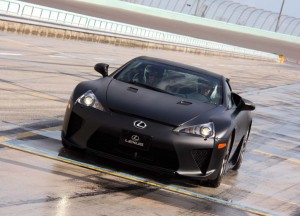
Every 2011 Lexus LF-A will be built to order, and buyers will have a wide range of options, including different colors for the Brembo calipers.
The only exception was during an occasional shift. Though Lexus defends the use of its SMG, we’d have much preferred one of the newer dual-clutch gearboxes most of the Europeans have now migrated to. The LF-A’s single-clutch systems takes a reasonably quick 0.2 seconds to shift, but that’s still several times slower than the similar Jaguar box. Not only can shifts hit with a bang, but the brief interlude between gears was one of the few times the sports car seemed out of balance, especially if you made the mistake of shifting in a corner.
There aren’t many things to complain about with the 2011 Lexus LF-A, other than the gearbox and the large blindspots. The scoops just behind the B-pillars have a serious impact on side visibility. That’ll be a particular problem on the road and, let’s face it, that’s where most people will wind up experiencing the new Lexus supercar.
If you think the performance numbers are impressive, the price tag will leave you gasping for air: though final figures haven’t been determined, Brian Smith, the division’s vice president of sales, says it will come in “somewhere between $375,000 and $390,000.” No surprise, then, that Lexus expects the LF-A to primarily appeal to the small but growing group of deca-millionaires, those who have a minimum $10 million in handy assets.
To enhance the appeal, only 500 of the cars will be built for global distribution. Even then, can Lexus move them all? Though Ferrari insists it still has a long waiting list, the overall ultra-luxury market has fallen into one of its worst slumps since the Great Depression. It’s a matter of image as much as assets, many potential buyers reluctant to drive up to the office in a new supercar when they’re about to begin another round of layoffs.
So anyone competing in the segment needs to make a solid case to keep the customers rolling in. Lexus, already known for its customer-friendly sales process, will go the next step. The company has created a unique LF-A website and a special 800-number for potential buyers to call. While sales will be handled through your local showroom, a special team of “associates” will be available to help complete the deal.
Every LF-A will be custom-built to order and buyers will have a surprisingly wide range of ways to customize the vehicle, down to the six shades of alcantra suede and half-dozen different colors for the huge Brembo brake calipers.
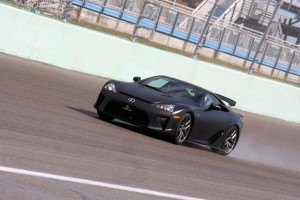
LF-A will use a new Bridgestone Potenza tire design so new neither company will discuss details yet.
But it ultimately comes down to the car itself. From both a design and engineering standpoint, the 2011 Lexus LF-A is a remarkable achievement. Yet one could argue it hasn’t gone quite far enough. The performance numbers are impressive, but the car doesn’t have the brutality of a Lamborghini or Aston Martin – nor the over-the-top looks of a Ferrari.
But when you consider where it comes from, the 2011 Lexus LF-A has made some remarkable achievements. You’re likely never to look at the Japanese brand the same way again. In the end, we expect there’ll be more than enough buyers for the 500 cars Lexus will build, and a lot more wannabes who’ll check out the rest of the marque’s line-up – and in the end, that’s one of the LF-A’s primary goals.
Production begins in December 2010, and the first customers likely won’t take delivery until the first weeks of 2011.

